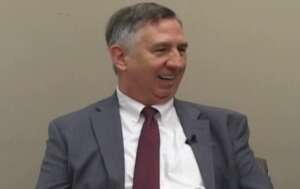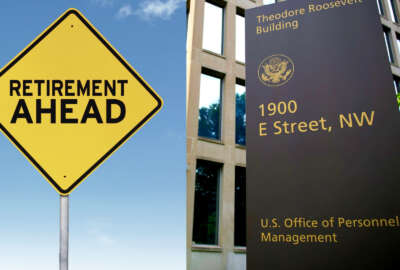TMF award to help OPM modernize COBOL code via AI
Guy Cavallo, the OPM CIO, said by using artificial intelligence to rewrite software code, the agency will need fewer programmers without losing oversight rigor.
The 40-year old COBOL code that runs the Office of Personnel Management’s retirement system is on a glide path to its sunset. OPM will embark on a two-year project starting in calendar year 2025 to modernize the underlying back end software, which will open the door for faster and easier front-end user focused services.
Guy Cavallo, OPM’s chief information officer, said the project’s goal isn’t to modernize every line of code, but rather transition the COBOL into Java Script or Python.

And the key to doing that in two years: Artificial intelligence and a boost from the Technology Modernization Fund board.
The board awarded OPM $18.3 million for the project. This is OPM’s third award from the TMF.
“What we went forward with the TMF board is not only were we going to modernize the mainframe code, but that we were looking at a model where there’d be a much smaller staff of programmers who would just validate and tweak the AI that’s rewriting the code, versus the traditional model of having an army of programmers reading the legacy code and then rewriting it into a modern language,” Cavallo said in an interview with Federal News Network. “We’re not just turning AI on it and putting it in production. Instead of having a developer army rewriting code and then doing quality assurance checks and validation, we will have the AI do the bulk of the rewriting and still do the full validation and confirmation checks.”
Cavallo said the programmers will still have the final say before any code is put into production. There also will be some parts of the code where the AI will not work and the programmers will have to do the heavy lift of the code rewrite.
He said OPM believes it’s going to be a fraction of the level of effort that it would take to rewrite every single line one at a time.
“My team brought in four or five vendors to demonstrate their capabilities with legacy COBOL. We saw enough out of those demonstrations to convince us that this is something that will be competed,” Cavallo said. “We will ask the vendor community to bid their best and brightest on this. But several vendors did highlight that they already are doing this type of conversion in the private sector, so we will make that as part of the evaluation. How have they demonstrated their success, and potentially will have them have to demonstrate on some of our code as part of the evaluation.”
As part of the retirement systems modernization effort, OPM will release a solicitation in the coming year for the project. Cavallo said he wasn’t sure about the exact timing of the request for proposals.
“I have to receive the TMF funding first. We’ve been developing an RFP over the last couple of months. I have a mainframe consulting team working with my team who will help draft the requirements, but obviously, because they’re drafting the requirements, they won’t be one of the firms bidding on that,” Cavallo said. “We’re getting that part of it ready while we wait for the funding to come. Once we get the funding, then we’ll be able to merge the money with the RFP and get it out on the street.”
And, of course, the TMF board doesn’t release funding all at once. It releases it in tranches, and Cavallo and his team will report back to the board quarterly on their progress.
Cavallo said the biggest impact of this code modernization effort is two-fold. First, OPM will be able to hire people who can keep the software up-to-date because it’s written in a modern language versus COBOL. But maybe more importantly, he said long term improvements will be easier as well.
“We’re already staffing up with new staff members that have those new modern language skills who will be part of this project. But it’s really about sustaining the long term operations of retirement services, and also by being in a modern programming language, it’s going to make it easier for us to modernize the actual applications and functions going forward,” he said.
Cavallo said he recognizes OPM’s retirement systems modernization effort has been filled with fits and starts over the last 35-plus years.
OPM has struggled to move the retirement process away from paper and modernize the systems it uses for much of the past three-plus decades. Over the last two years, lawmakers and auditors highlighted the challenges and need to modernize these processes.
In April 2023, lawmakers wrote to OPM seeking answers when the backlog reached almost 23,000 claims and the average time to process a retiree was 81 days.
Then in November 2023, OPM’s inspector general also found ongoing shortcomings in OPM’s planning and execution.
“We’ve been working on modernizing several specific modules of the retirement services process. Right now, our online retirement application is in pilot mode, which it has been for most of 2024. We are working directly with the National Finance Center and the agencies that they support to add this new function to it,” Cavallo said. “We’ve learned a lot from the pilot. We’ll be making some adjustments before we make it available for the rest of the government payroll centers. That’s an example where we’re not just waiting and doing these one at a time. Several of these type of capabilities are going to be done in parallel, and like the retirement application part, even after we modernize the mainframe into a new programming language, we could potentially replace that language with the new online retirement application module. We’re looking at modernizing modules as we go, but it’ll be much easier once it’s written in a modern programming language to do so.”
OPM also has been testing a digital file system to replace the paper documents that federal employees accumulate over the course of their careers.
Cavallo said the goal is when someone retires, their entire working history is digital.
“They can check on their status of their process and make sure that that all of their federal career documentation is there. We already started that in 2024 and we’ll have that foundation continue to be built out in 2025 and probably be in production by the end of 2025 or 2026 just in time as we modernize the legacy code that goes with it,” he said.
Copyright © 2025 Federal News Network. All rights reserved. This website is not intended for users located within the European Economic Area.
Jason Miller is executive editor of Federal News Network and directs news coverage on the people, policy and programs of the federal government.
Follow @jmillerWFED





